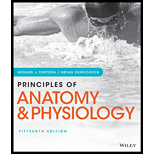
Concept explainers
To review:
The approximate volume of each of the body fluid compartments.
Introduction:
Body fluid is generally a liquid substance produced in the body and is made up of water as well as dissolved solutes. The percentage of body fluid with respect to the body mass varies in the male and female body. In a female body, the body fluid is about 55% (percent) of the total body mass and the percentage of the body fluid in a male body is about 60% of the total body mass.
Explanation of Solution
There are two main compartments, in which the body fluids are present, inside the cell and outside the cell. Based on the location, the body fluids are known as intracellular fluid or ICF and extracellular fluid or ECF.
ICFs are the fluid present within the cells and are the principal component of the cytoplasm or the cytosol. The ICF in the body makes up around 60% of the total water content within the body. ICFs are about two-thirds of the total body fluid.
ECFs are fluids present outside the cells and make up about one-third of the body fluid. It is made up of blood plasma and interstitial fluid. Eighty percent of ECF is interstitial fluid found in between the microscopic spaces of the tissue cells. The fluids, which are present along with interstitial fluid, are cerebrospinal fluid found in the nervous system, vitreous body and aqueous humour found in eyes, the synovial fluid found in joints, lymph present in lymphatic vessels, and peritoneal, pericardial, and pleural fluids found between the serous membranes. The remaining 20% ECF is blood plasma, which is the liquid component of the blood.
Thus, the main compartments, in which the body fluids are categorized, are ICF that makes up two-thirds of the total body fluid and ECF, which makes up rest of the volume.
Want to see more full solutions like this?
Chapter 27 Solutions
Principles of Anatomy and Physiology
- ✓ Details Draw a protein that is embedded in a membrane (a transmembrane protein), label the lipid bilayer and the protein. Identify the areas of the lipid bilayer that are hydrophobic and hydrophilic. Draw a membrane with two transporters: a proton pump transporter that uses ATP to generate a proton gradient, and a second transporter that moves glucose by secondary active transport (cartoon-like is ok). It will be important to show protons moving in the correct direction, and that the transporter that is powered by secondary active transport is logically related to the proton pump.arrow_forwarddrawing chemical structure of ATP. please draw in and label whats asked. Thank you.arrow_forwardOutline the negative feedback loop that allows us to maintain a healthy water concentration in our blood. You may use diagram if you wisharrow_forward
- Give examples of fat soluble and non-fat soluble hormonesarrow_forwardJust click view full document and register so you can see the whole document. how do i access this. following from the previous question; https://www.bartleby.com/questions-and-answers/hi-hi-with-this-unit-assessment-psy4406-tp4-report-assessment-material-case-stydu-ms-alecia-moore.-o/5e09906a-5101-4297-a8f7-49449b0bb5a7. on Google this image comes up and i have signed/ payed for the service and unable to access the full document. are you able to copy and past to this response. please see the screenshot from google page. unfortunality its not allowing me attch the image can you please show me the mathmetic calculation/ workout for the reult sectionarrow_forwardIn tabular form, differentiate between reversible and irreversible cell injury.arrow_forward
- 1.)What cross will result in half homozygous dominant offspring and half heterozygous offspring? 2.) What cross will result in all heterozygous offspring?arrow_forward1.Steroids like testosterone and estrogen are nonpolar and large (~18 carbons). Steroids diffuse through membranes without transporters. Compare and contrast the remaining substances and circle the three substances that can diffuse through a membrane the fastest, without a transporter. Put a square around the other substance that can also diffuse through a membrane (1000x slower but also without a transporter). Molecule Steroid H+ CO₂ Glucose (C6H12O6) H₂O Na+ N₂ Size (Small/Big) Big Nonpolar/Polar/ Nonpolar lonizedarrow_forwardwhat are the answer from the bookarrow_forward
 Human Physiology: From Cells to Systems (MindTap ...BiologyISBN:9781285866932Author:Lauralee SherwoodPublisher:Cengage Learning
Human Physiology: From Cells to Systems (MindTap ...BiologyISBN:9781285866932Author:Lauralee SherwoodPublisher:Cengage Learning





